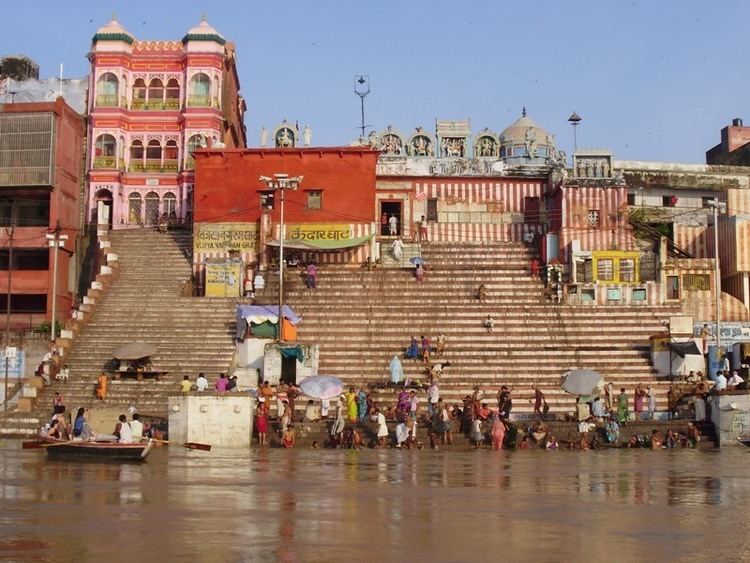 | ||
Ghats in Varanasi are riverfront steps leading to the banks of the River Ganges. The city has 87 ghats. Most of the ghats are bathing and puja ceremony ghats, while a few are used exclusively as cremation sites.
Contents
- List of ghats
- Dashashwamedh Ghat
- Manikarnika Ghat
- Scindia Ghat
- Maan Mandir Ghat
- Lalita Ghat
- Bachraj Ghat
- Other
- Cremation on ghats
- Pollution of ghats
- References
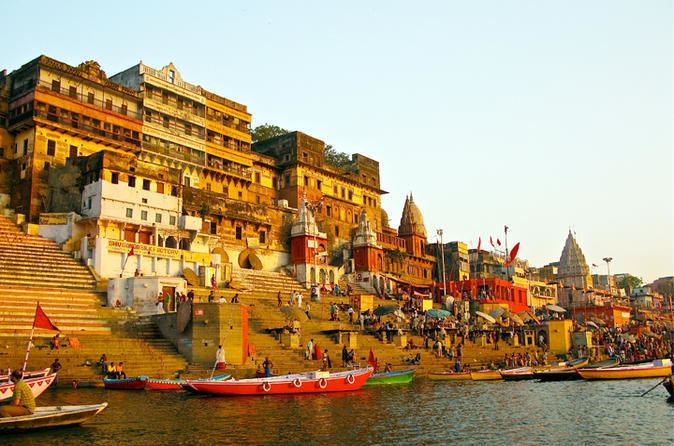
Most Varanasi ghats were built after 1700 AD, when the city was part of Maratha Empire. The patrons of current ghats are Marathas, Shindes (Scindias), Holkars, Bhonsles, and Peshwes (Peshwas). Many ghats are associated with legends or mythologies while many ghats are privately owned. Morning boat ride on the Ganges across the ghats is a popular visitors attraction.
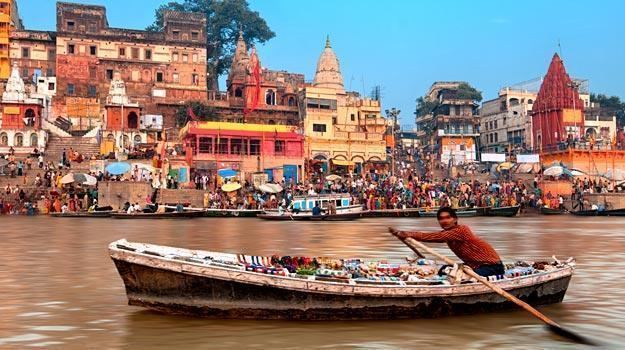
List of ghats
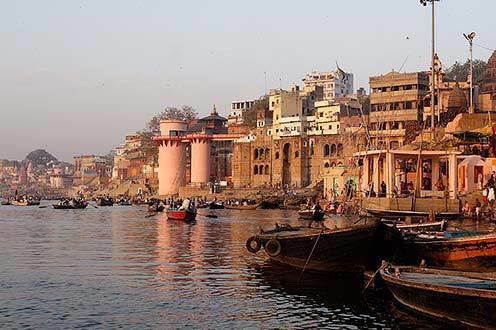
The ghats as named and counted by the city of Varanasi with supplementing links, listed in ascending order according to their location (from Assi Ghat to Adi Keshawa Ghat):
Part 1: from Assi Ghat to Prayag Ghat (1-41)
Dashashwamedh Ghat
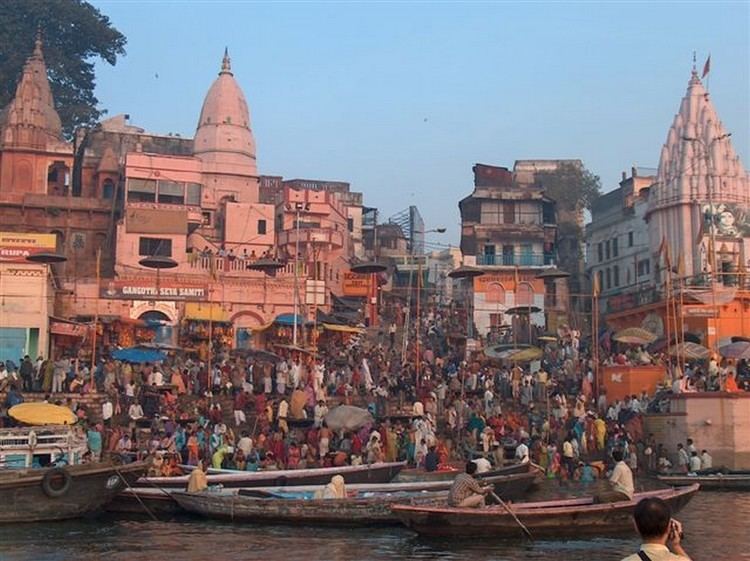
Dashashwamedh Ghat is located close to Vishwanath Temple, and is probably the most spectacular ghat. Two Hindu mythologies are associated with it: According to one, Lord Brahma created it to welcome Lord Shiva. According to another, Lord Brahma sacrificed ten horses, during Dasa-Ashwamedha yajna performed here. A group of priests daily perform in the evening at this ghat "Agni Pooja" (Worship to Fire) wherein a dedication is made to Lord Shiva, River Ganges, Surya (Sun), Agni (Fire), and the whole universe.
Manikarnika Ghat
Two legends are associated with Manikarnika Ghat. According to one, it is believed to be the place where Lord Vishnu dug a pit with his Chakra and filled it with his perspiration while performing various penances. While Lord Shiva was watching Lord Vishnu at that time, the latter's earring ("manikarnika") fell into the pit. According to the second legend, in order to keep Lord Shiva from moving around with his devotees, his consort Goddess Parvati hid her earrings, and asked him to find them, saying that they had been lost on the banks of the Ganges. Goddess Parvati's idea behind the fib was that Lord Shiva would then stay around, searching forever for the lost earrings. In this legend, whenever a body gets cremated at the Manikarnika Ghat, Lord Shiva asks the soul whether it has seen the earrings.
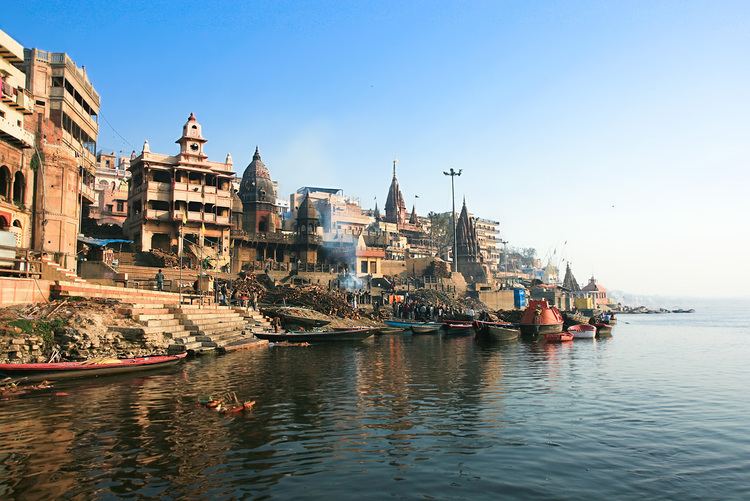
According to ancient texts, the owner of Manikarnika Ghat bought King Harishchandra as a slave and made him work on the Manikarnika at Harishchandra Ghat. Hindu cremations customarily take place here, though a majority of dead bodies are taken for cremation to the Manikarnik Ghat. According to other sources that Manikarnik Ghat is named after Jhansi ki Rani Laxmibhai.
Scindia Ghat
Scindia Ghat also known as Shinde Ghat borders Manikarnika to the north, with its Shiva temple lying partially submerged in the river as a result of excessive weight of the ghat’s construction about 150 years ago. Above the ghat, several of Kashi’s most influential shrines are located within the tight maze of alleys of Siddha Kshetra (Field of Fulfillment). According to tradition, Agni, the Hindu God of Fire was born here. Hindu devotees propitiate at this place Vireshwara, the Lord of all heroes, for a son.
Maan-Mandir Ghat
Mana-Mandir Ghat: Maharaja Jai Singh II of Jaipur built this Ghat in 1770, as well as the Jantar Mantar equipped with ornate window casings along with those at Delhi, Jaipur, Ujjain, and Mathura. There is a fine stone balcony in the northern part of the ghat. Devotees pay homage here to the lingam of Someswar, the Lord of the Moon.
Lalita Ghat
Lalita Ghat: The late King of Nepal built this Ghat in the northern region of Varanasi. It is the site of the Ganges Keshav Temple, a wooden temple built in typical Kathmandu style,The temple has an image of Pashupateshwar, a manifestation of Lord Shiva. Local festivals including musical parties and games regularly take place at the beautiful Assi Ghat which is at the end of the continuous line of ghats. It is a favorite site of painters and photographers. It is here at the Assi Ghat that Swami Pranabananda, the founder of Bharat Sevasharam Sangh,attained 'Siddhi' (fulfilment/success) in his 'Tapasya' (endeavor) for Lord Shiva, under the auspices of Guru Gambhirananda of Gorakhpur.
Bachraj Ghat
The Jain Ghat or Bachraj Ghat is a Jain Ghat and has three Jain Temples located on the banks of the River. It is believed that the Jain Maharajas used to own these ghats.Bachraj Ghat has three Jain temples near the river's banks and one them is a very ancient temple of Tirthankara Suparswanath.
Other
Man Singh of Amber built Maan-Sarowar Ghat. Maharaja of Darbhanga built Darbhanga Ghat. Tulsidas wrote Rāmacaritamānasa at Tulsi Ghat.
The headquarters of the Sri Kashi Math Samsthan, a spiritual school followed by the Konkani speaking Goud Saraswat Brahmins, is located in Brahma Ghat.
Cremation on ghats
In Hindu traditions, cremation is one of the rites of passage and the Ghats of Varanasi are considered one of the auspicious locations for this ritual. At the time of the cremation or "last rites", a "Puja" (prayer) is performed. Hymns and mantras are recited during cremation to mark the ritual. The Manikarnika and Harishchandra Ghats are dedicated to the cremation ritual. Annually, less than 2 in 1000 people who die in India, or 25,000 to 30,000 bodies are cremated on various Varanasi Ghats; about an average of 80 per day. This practice has become controversial for the pollution it causes to the river. In 1980s, the Government of India funded a Clean Ganges initiative, to address cremation and other sources of pollution along the Ghats of Varanasi. In many cases, the cremation is done elsewhere and only the ashes are dispersed into the river near these Ghats.
Pollution of ghats
Untreated sewage is a pervasive source of river pollution in India. City municipal waste and untreated sewage is the largest source of pollution of Ganges river near the Ghats of Varanasi.
